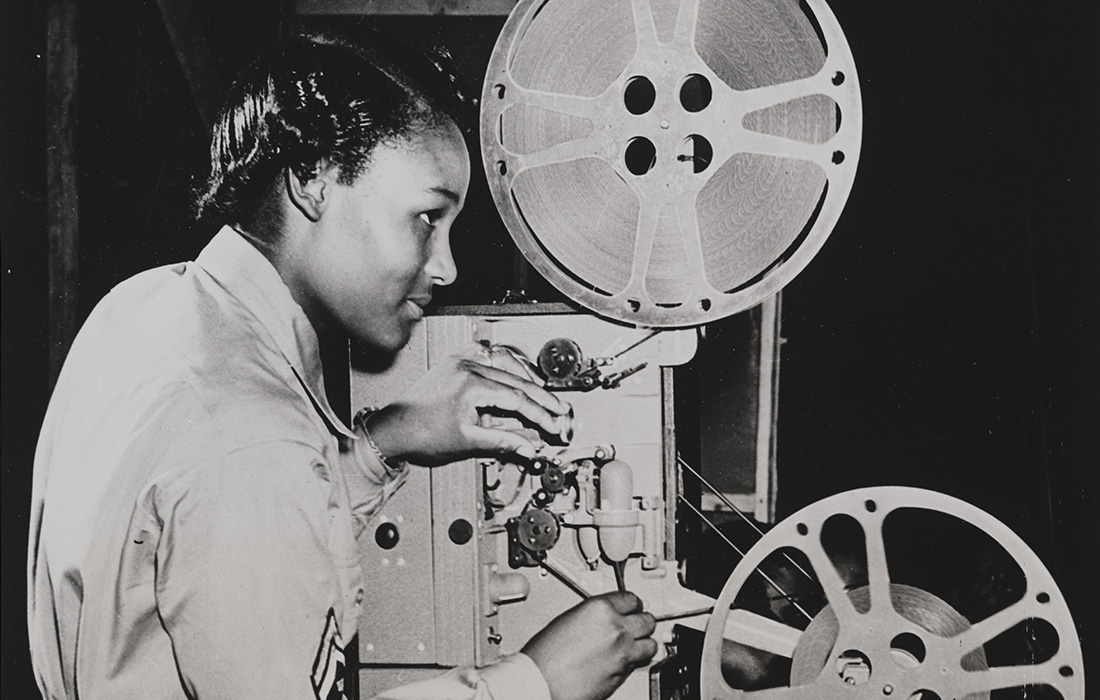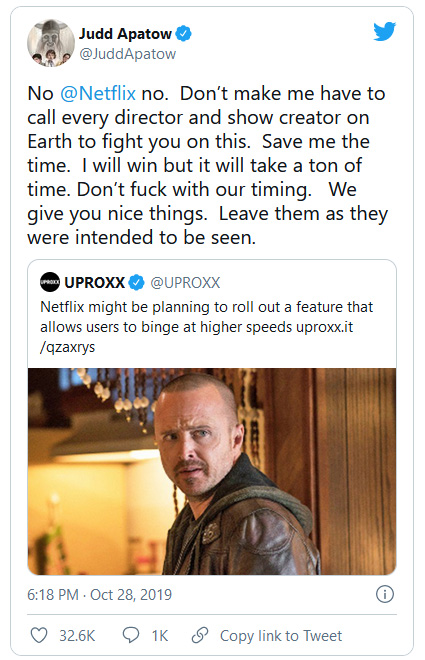
Susan Baptist, a projectionist, shows training films for the troops as well as more popular motion pictures, 1940-1950 | Library of the Congress | No known restrictions on publication
For some years now, podcast and video platforms and messaging apps have been offering variable speeds of reproduction, leading to new consumer practices. The possibility of speeding up reproduction is not new, nor is it exclusive to digital tools, and it has generated a range of debates and arguments from the point of view both of reception and of those who created the contents.
Messaging apps are the latest to offer variable speeds of reproduction. You no longer need to listen to voice messages at the speed at which they were recorded; you can speed up reproduction by as much as half. For some years now, this possibility has been available, first on podcast and then on video platforms, giving rise to new reception practices. Podfasting or speed watching is the action of accelerating the reproduction of digital content. The main argument for this practice is, of course, time. Get more in less; watch two episodes in the time of one, listen to three shows in the time of two, and get things off your to-do list. That this is a sign of the times is evident, irrespective of who does it and who doesn’t. It is one symptom more of a digital economy that exploits attention as a limited resource, in which the usual rhythms are a frontier to be pushed beyond and overcome.[1]
The first mentions of these practices came in around 2016 in newspaper articles about them, as well as numerous posts on forums explaining the experience or the surprise they represented. They include a range of debates and arguments, most from the point of view of reception but also some from the creators of the contents. If time is the first argument, associated with a kind of obligation to “keep up to date” with a large amount of available content, there are others, such as a desire for completion. Finding a new podcast and wanting to listen to all the previous shows or thinking about watching a series and needing to complete all the seasons; these needs seem to spring from the apparent archival logic that underpins many internet platforms and also from a kind of collector’s urge.
From the viewpoint of creation, there is a resistance to accepting practices like these (asking for these options not to be implemented on interfaces, for example), arguing that seeing or hearing in this way destroys the object and its effects. No one denies that this is so, but there are parallel arguments that displace or nuance the case for destruction. In many cases there is a division between the information conveyed and the work as such, where the idea is that even if we do not watch the series or listen to the podcast as it was intended, we do extract all the information (we know what happens, we know what has been talked about). This argument collaterally produces an interesting categorization of cultural objects in which music seems resistant to this kind of decomposition of the elements: an audio streaming service like Spotify offers variable playback for podcasts but not for music. Another related reasoning is that of users who claim that the increase in speed adapts the pace of the work to their interests and need for stimuli. If this formula is based on personalization, it is interesting to note that podfasters often explain that listening to or watching speeded-up reproductions is a kind of training in which they move on to ever-faster speeds, as if trying to acquire a new ability.
Observing this particular practice, like so many others, can be fascinating as you get to the bottom of the matter and see the ramifications. Finally, it seems that this is not a concern to advertisers (according to the platforms’ corporate reaction to avoid losing this income). The impact of the ad is not lost, and it is even argued that it can be greater, as those listening or watching are less likely to skip ad breaks. But this practice interests us not only as part of the present, but also because it resonates with the past.
In the history of technology and the media it is quite common, and often particularly interesting, to find parallels between historical facts and the present. Rather than repetitions in themselves, they are resonances, or a pattern or similarity that is detected because the present has been put into perspective, allowing a figure or element to stand out that did not before.[2] These relationships prompt us to take a fresh look at our environment and perhaps vary the way we characterize it. In some cases, the symptoms of the present cease to be seen as a novelty and are revealed as a chronic situation. In others, the past works as a kind of outline that, superimposed on the present, offers a chance to understand it in a different way. This case of variable playback goes back, for example, to previous situations such as the widespread presence of the video player in the home. But it particularly resonates in relation to the early decades of the cinema.
From the first devices of the late nineteenth century until the 1930s, the cinema did not have a standardized speed of reproduction. Paolo Cherchi Usai writes probably one of the best summaries of this subject in his book Silent Cinema,[3] on which some of the information explained here is based. The range of images per second used could vary between frequencies of 13 and 28 (or even lower in particular cases, such in Japan, apparently in order to save film). Our digital players, alternatively, express the speed of reproduction starting with a standard speed of x1 and proposing variations as multiples (x1.5, x1.75, x2, etc.). We can create an equivalence between these two magnitudes; if we take 16 images per second, a fairly common frequency in the early twentieth century, as the unit (the digital x1), then a speed of 24 images per second would be equivalent to x1.5.
At that time, most cameras and projectors were operated manually, so it was the speed of the hand that governed the number of images per second (though there were also models in which this function was motorized, becoming more widespread in the 1920s). This means that the only strictly measurable speed was the number of turns of the crank per time unit (two turns being more or less the 16 frames per second mentioned). Both in capturing and projecting images, the cinema was a device involving a machine and a person (camera and operator, projector and projectionist), and as a global system it involved these two combinations that did not necessarily match. That is, it was strictly impossible exactly to reproduce the images at the same speed at which they had been filmed; in fact, this was not even the way it was supposed to be done.
Frame rate per second was not a matter of synchrony between the two pre-established speeds of capture and projection, as in both phases this speed was, in itself, variable. Both during the filming and in the cinema, the film could be made to go faster or slower at certain moment and according to different criteria. During filming it could be due to questions of exposure (slower filming made it possible to shoot in less light), but also the action taking place in front of the camera, such as comic or action scenes, could be shot at slower rotational speeds so that it could be accelerated when projected). In Luigi Pirandello’s novel Quaderni di Serafino Gubbio operatori, the protagonist is asked about his role as a camera operator and he answers the following:
“Are you really necessary? What are you? A hand that turns the crank. Couldn’t this hand be dispensed with? Couldn’t it be suppressed, replaced by some mechanism?”
I smiled and answered:
– Perhaps in time, sir. To tell the truth, the main quality that is required in one who carries out my profession is impassivity in the face of the action that takes place in front of the camera. A mechanism, in this respect, would certainly be more appropriate and preferable to a man. But the most serious difficulty, for now, is this: finding a mechanism that can regulate movement according to the action that takes place in front of the camera. Because I, dear sir, do not always turn the crank in the same way, instead faster or slower, as needed. However, I do not doubt that with time—yes sir—I will be suppressed. The camera—this camera too, like many other cameras—will film by itself. But what man will do when all the cameras turn by themselves, this, dear sir, remains to be seen.[4]
In the cinema, the same criterion of variability prevailed, this time in the hands of the projectionist, who could decide to speed up or slow down the images depending on the action taking place.
But if the issue of speed was literally in the hands of these two agents of the device, they weren’t the only ones to have a say. The variability of speed was also an important question for the construction of the film, with instructions being given as to the speeds it should be projected at, part by part (Cherchi Usai gives the example of films by Griffith in which he specifies the length each roll of film must have when projected and even, within a roll, variation of the speed between the beginning and the end). The musicians, too, whether they were composers commissioned to write music or the cinema’s own, could request one speed or another (for example, Gottfried Huppertz’s score for Metropolis was intended for a projection of 28 images per second). Lastly, the owners or managers of the cinemas influenced the speed of screening, usually asking for it to be increased, as the faster the films were shown the more sessions could be held. All of these decisions, moreover, influenced each other. For example, assuming the film would invariably be projected faster could lead to filming at higher speeds to adapt to this situation. And, of course, it also led to conflicts between the parties. Cherchi Usai tells the story, documented in a Danish newspaper, of a director who angrily protested at the screening of one of his films, which was reduced from an expected hour and a half to 50 minutes.
This should not be seen as a mere corporate discussion between producers and exhibitors. In some countries there was legislation on the matter: in the Soviet Union in the 1920s, it was forbidden to exceed a speed of 25 metres of film per minute (the equivalent of about 22 frames per second). In the field of medicine, when discussing the possible harmful effects of cinema—just like the discussion of the physical and psychological effects of present-day devices—this question was also raised, warning of the dangers of excessively high or low speeds. The public was also aware of this variability in reproduction. This, for example, is recorded in the diary that Walter Benjamin kept on a trip to Moscow in late 1926, writing about one of his visits to the cinema: “The film turned out to be an unbearable botch and they projected it at such a dizzying speed that it was impossible to watch or understand. We left before it was over.”[5]
All of these practices came to an end in the history of cinema due to the incorporation of synchronous sound. The film soundtrack, unlike the image, does not support variable reproduction. While the illusion of motion is not destroyed by altering the frame rate per second, changing the frequency of reproduction of the sound leads to a change in pitch. If the speed varies in the projection, voices and sounds change tone, presumably annoying the audience. It is interesting that this acceleration of reproduction has now taken place first in the world of sound. The supposed annoyance at change in tone is now corrected automatically in real time so as not to alter the voices.
As this case shows, variable reproduction is nothing new, nor is it exclusive to digital tools. For three decades it was a common practice, in some cases raising similar concerns to today’s (including those of the creators of the works about the use that is made of them). What has changed today is that it is the public who has control over the reproduction rather than the exhibitor (though it is the latter—the platform—that offers this option on its interface). While it was the economic criterion that prevailed for many exhibitors at the time, wanting to squeeze in the maximum number of sessions, despite the protests of those who had produced the work or someone walking out of the cinema, it is symptomatic today that practices like podfasting or speed watching are a kind of application of this assumption to ourselves. Superposing the historical and the present-day pattern, today we take on two roles at once, treating ourselves according to the criteria of economic efficiency (more in less) even if it spoils our enjoyment of being a spectator or listener. Now that so many cameras seem to be turning and looking on their own, must there be someone travelling to Moscow who is trying, finally, to get through a season of Mad Men?
[1] On these subjects see authors such as Nick Srnicek, Jonathan Crary, Helen Hester and Bifo Berardi.
[2] We address some of these issues in the text “De nou el vell i el nou de nou” in the book Imatges, un domini públic(CCCB, 2020). This approach is close to that of media archaeology proposed by authors such as Erkki Huhtamo.
[3] Paolo Cherchi Usai: Silent Cinema. A Guide to Study, Research and Curatorship (third revised edition), BFI, 2019.
[4] Luigi Pirandello: Quaderni di Serafino Gubbio operatore. Citation translated by the translator of this text.
[5] Walter Benjamin: Moscow Diary. Harvard University Press, 1986.






Leave a comment